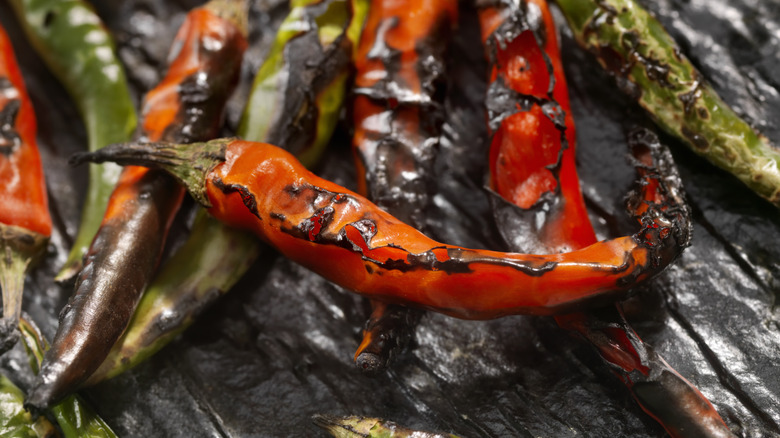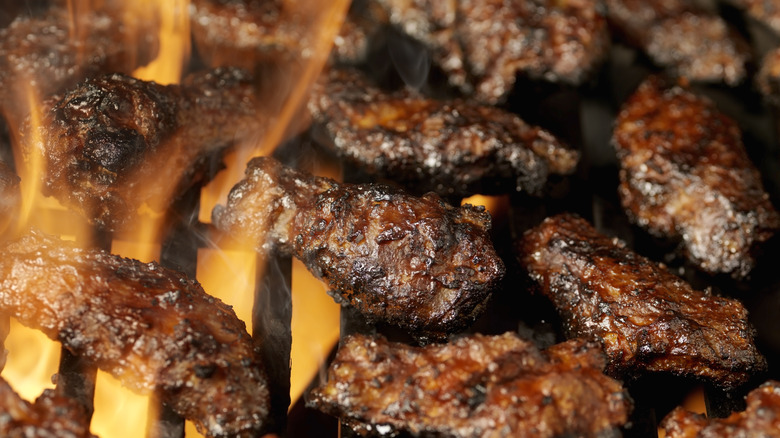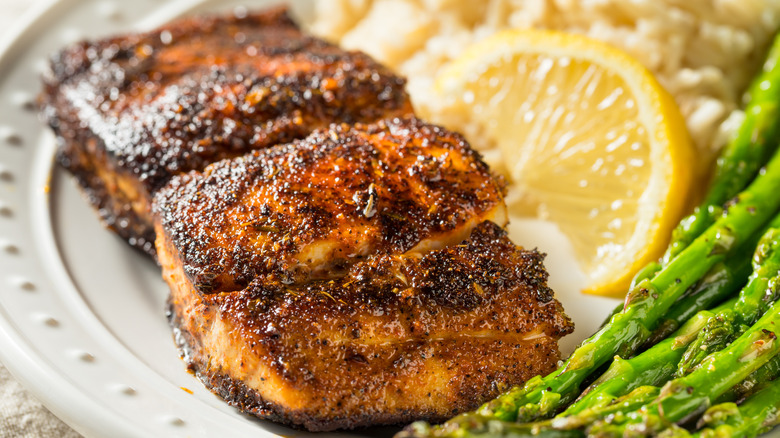No, Charring Food Isn't The Same As Blackening It
Cooking your meats, fish, or veggies until they're slightly burned can impart a delicious depth of flavor and a crispy crunch to every bite. From breakfast sausages and grilled corn on the cob to creme brulee and, of course, marshmallows for s'mores, there's no denying that some foods simply taste better when browned. Of course, there's a variety of words that can be used to describe these types of foods, but you may be most familiar with cooking terms like "charred" and "blackened." But, although the two words are often used interchangeably, they're actually two entirely different cooking techniques.
Granted, it's not hard to see why charred and blackened foods are easily confused. After all, they certainly look the same on the outside thanks to their burnt appearances — even though blackened foods aren't actually burnt. But, aside from their visual similarities, they do differ in one very important way: the way they taste. Of course, charred and blackened foods can certainly taste equally delectable in their own ways, and the former is usually renowned for its multi-dimensional burnt flavors, including its signature smoky taste. However, blackened foods do feature a little something extra in the form of an enticing seasoning blend that's slathered on before cooking for added flavor. That's right: Blackened food has a delicious crust of spices and seasonings.
Charred foods feature a smoky flavor
When it comes to charring foods, the cooking process is essentially an extension of the Maillard reaction. In a nutshell, the reaction is the browning that occurs on the exterior of certain foods due to a chemical response between the amino acids and reducing sugars when cooked at high temperatures.
Charring is similar to this reaction, but it takes things one step further by cooking foods just beyond the point of caramelization. This helps to add a complex burst of bitter, smoky, and umami flavors to foods, especially those that are naturally high in sugar like corn, onions, sweet potatoes, and beets. Just be sure to take your foods off the heat before they're overly burned to a crisp and inedible.
Although charring is more commonly associated with grilling on the barbecue, you can certainly sear your proteins or veggies in a pan, such as a cast-iron skillet, or broil them in the oven to achieve much the same effect.
Blackening involves the use of spices and herbs
Charred foods may have been around for ages (quite literally as scientists believe this is how early hunter-gatherers prepared their food), but the blackening technique is said to have originated sometime in the 1980s. It was reportedly popularized by the late chef Paul Prudhomme who famously used the technique to prepare a fish fillet using his signature Cajun herbs and spices (per NPR). Using a blend of herbs and spices is key to making any blackened dish, from meats like chicken and steak to various types of seafood. But, although blackened foods appear burnt in appearance, their dark coloring actually stems from their cooked coating of seasonings.
The cooking method entails dipping food in melted butter and rubbing it with herbs and spices, such as garlic and onion powder, paprika, thyme, and cayenne pepper for a spicy kick. (You can whip up a homemade blackening seasoning or buy one ready-made at the store from brands like Old Bay or Zatarain's.) Then, the food is cooked over high heat until the deeply browned or blackened crispy crust forms. Similar to how charred foods are typically cooked over a grill or open flame, blackened foods are usually prepared in a hot pan, but a grill or oven can also be used to blacken foods to perfection.



